A number of new half-ton trucks no longer even offer V8 engines; the rest offer them as optional engines. Only one half-ton truck still comes standard with one.
That would be Nissan’s Titan – which hasn’t been “updated” much since the 2016 model year.
If you like a truck like they used to build ‘em, that is a very good thing.
The Titan is Nissan’s rival to the Chevy Silverado, Ford F-150, Dodge Ram and Toyota Tundra half-ton (1500 series) pick-ups.
It is the oldest 2023 truck of the bunch because the current truck is essentially the same truck as the 2016 model – only you can still buy it brand-new, with zero miles on the clock and a new vehicle warranty. The best whole-vehicle warranty (five years, 100,000 miles) in the segment.
You may be very interested in buying this truck, too – if you don’t want a new truck – in terms of all the things that have changed since 2016.
Including the downsizing of what comes standard under the hood.
The newest of the 1500s – Toyota’s Tundra – no longer offers a V8 engine at all. The only engine is a V6/hybrid combo. The Dodge Ram 1500, Chevy Silverado 1500 and Ford F-150 still offer V8s, but all of them optionally.
That leaves the Titan as the last new 1500 that still comes standard with a titan under its hood.
Prices start at $39,700 for the base S trim King cab, with 2WD and a standard 400 horsepower 5.6 liter V8 engine. Which is also why this truck comes standard with a 9,300-lb. tow rating. Both the engine and the pulling power are more of each than comes standard in any of the Titan’s lesser-engined rivals.
A top-of-the-line Platinum Crew Cab with 4WD – and the same 400 horsepower V8 – stickers for $61,980.
There are two bed lengths – 6.5 feet and 5.5 feet. The one you get depends on which cab you pick. Crew cabs – with four full size doors and more room inside for passengers – get the shorter 5.5 foot bed. King Cabs – with two standard-sized and two smaller-sized rear doors – and less room for passengers – get more room for cargo . . . in the standard 6.5 foot bed. 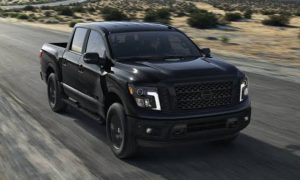
What’s New For 2023
Very little. Which is very good – if you are looking for a pick-up like they used to make ’em.
A Midnight Edition with blacked-out styling elements is available – but only with Crew Cab versions.
What’s Good
Most standard horsepower and towing capacity in the class.
All steel (rather than aluminum) construction.
Available with a three-across bench seat, just like they used to make ’em.
What’s Not So Good
Not available in two-door/regular cab configuration.
The longest-available bed is only 6.5 feet long.
Rivals can tow more when equipped with their optionally available engines.
Every Titan – irrespective of trim – comes standard with the biggest, strongest standard engine in the class. It’s a 5.6 liter V8 that makes 400 horsepower and 413 ft.-lbs. of torque.
Back in 2016, this engine would have been typical rather than unusual – because back then (only sseven years ago!) it was still feasible for the companies that make trucks to mass-market V8s. It isn’t anymore – because of the federal regulatory regime that practically criminalizes the mass-marketing of V8s. It does so via punishing the mass-marketing of big engines that use a little more gas than smaller engines – and that “emit” (gotta love government-speak) a little more carbon dioxide gas. This is why – as a for-instance – Toyota replaced the previously standard V8 in the Tundra with a much smaller 3.5 liter V6, turbo boosted to make up for the lost displacement (when under boost) and that (theoretically) “emits” less gasses when not under boost.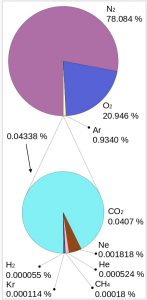
But when you look at it, it’s a pretty meager difference – truck to truck.
The new Tundra’s V6 carries an EPA rating of 18 city, 24 highway; the Nissan’s V8 rates 16 city, 21 highway. It’s a difference of about 3 MPG overall. Which isn’t much of one. A biggere difference is the Nissan’s 9,300 lb. standard towing capacity vs. the Tundra’s significantly lesser 8,300 lb. rating – with the standard (348 horsepower) version of the 3.5 liter V6. A stronger (437 horse) version is available, but costs extra. So equipped, the Tundra tows more (10,340 lbs.) than the Titan – but neither the horsepower nor the capacity are standard.
The stats stack up similarly vs. the other 1500s.
Now, you might ask: Why go to all that trouble – and cost – to eke out three more MPGs (on paper, on government fuel-efficiency tests) by nixing the V8 in favor of a V6, turbo-boosted and hybridized? It surely doesn’t matter to the individual truck buyer, who more than likely would rather have the V8 than the three more MPGs . .. and the V6. Which requires sound augmentation technology to sound like a V8.
So . . . why?
The answer can be adduced in two words: Fleet averages. The government factors out a given car manufacturer’s overall fleet average fuel efficiency as the basis for whether it will levy fines – for “guzzling” gas – on that company. Even more onerous are the regs pertaining to those “greenhouse gas emssions” – that is to say, carbon dioxide. All 0.04 percent of it, that fraction being the fraction of the Earth’s atmosphere C02 constitutes. We are told that a fractional increase in this fractional percentage is causing the “climate” to “change.”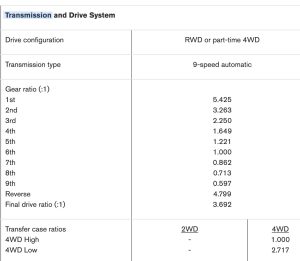
That is an assertion – of a piece, in terms of its evidentiary support, with the one that asserts “masks” (any “mask”) “work.”
But very real are the costs of non-compliance, especially moving forward, as these regulatory regimes reach their inevitable elaboration and place a chokehold on combustion engines, regardless of size. This push toward no engines at all – in favor of electric motors – is why the newer trucks (like the Tundra) have smaller engines while the oldest new truck – the Titan – still comes standard with a proper engine for a big truck.
A nine speed automatic is paired with the Titan’s big V8 and it has three overdrive gears (7th, 8th, 9th) with 9th being an incredibly deep 0.597 ratio. Which is how this big engine manages to use only a bit more gas than a small V6.
You can, of course, choose either 2WD (rear-drive) or 4WD, with a two-speed transfer case.
The Titan is one of the few new trucks that still drives like an older truck – heavy and solid – because it is. No aluminum panels to cut weight – and add to your cost of repairs (and probably also insurance premiums, for just that reason). A solid rear axle and leaf springs in the rear – simpler and more inherently rugged because there’s less to break or wear out than an independent/coil-spring rear. The price you pay for this truckish ruggedness is, of course, a less car-like ride, especially on unpaved roads. You will feel some axle hop reverb, but this can be tamped down by slowing down.
But you’ll feel – and hear – something else, even better. The sound of the Titan’s big V8. It makes a big sound – without need of augmentation. EVery time you start ‘er up, you’ll hear a sound that is the yin-yang opposite of what you don’t hear when there’s nothing more than a V6 up front and they don’t want you to hear it, because it’s inappropriate. A V6 is a fine engine – in a Camry. It is disappointing in a half-ton truck, which is why they tamp down how it sounds and then augment the sounds with a soundtrack of what they hope you won’t notice is missing.
The turbo-hybrid Toyota is quicker. But the Titan sounds better – because its sound is real. There is also the comfort that attends knowing there are no turbos to cook off, no 48 volt electric system to fritz out, no electric motors, just a 12 Volt starter battery and probably 200,000-plus miles before anything goes wrong with the proven-solid V8.
It would be even better with a five speed automatic and just one overdrive – but Nissan (like all of them) had to add mutliple overdrive gears to keep the V8, at least for the now. The good news is it’s a well-programmed automatic that doesn’t go past sixth or seventh until you’re stead-state cruising at highway speeds, so you don’t notice the extra gears much.
You may notice the wide-load (48 foot) turning circle, which is partly a function of the King/Crew-only (no regular cab) layout. It is also probbly why Nissan does not offer an eight-foot bed with this pick-up as that would probably push the turning circle past 50 feet.
On the other hand, the steering isn’t electrically-assisted (rack and pinion, instead) and so hasn’t got that absence of feedback (or artifical feel) you get with electrically-boosted power steering. In addition, it’s just a simple (again) hydraulic pump and lines, which will probably cost you less when it fails than an electrically-assisted system and its components.
One more mention that’s of a piece is the manual (foot pedal) emergency brake. Another old school interface that is arguably preferable to an electrically-engaged parking brake, which can’t be modulated by varing pressure, as is possible with a manual (and cable-controlled) emergency brake pedal.
Finally, you may be happy to know that while a number of “driver assistance” and “safety technologies” are embedded in the Titan (every trim) including Lane Departure Warning (for the sail-fawn addled and “vaccinated”) and Automatic Emergency Braking (which brakes for berms not in the road as well as objects far away you’re not in any danger of running into) they are all easily disabled, leaving you behind the wheel of a new truck that drives and feels and sounds a lot like trucks the way they used to make them – all of six or seven years ago.
The half-ton truck segment has changed a lot over the past decade or two. Half-tons used to be mostly simple and rugged, designed for people who need them as opposed to people who drive them largely because they remind them of the full-size, body-on-frame, big-engined/rear-drive cars they’re no longer allowed to buy – almost all of them having been force-retired by the same regulatory regime that is in the process of force-retiring V8 engines in trucks.
This is why the generl emphasis on car-like civility and luxury-car amenities. It is also why almost all of the current half-tons are not available in regular cab configuration and some (like the Titan) are unavailable with the eight-foot bed that used to separate a full-size pick-up from a compact-size pickup.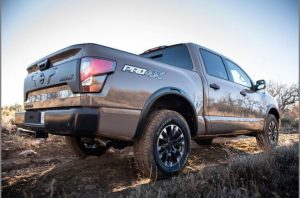
This writer owns one of the latter – an ’02 Nissan Frontier – and while it cannot pull even half what the Titan can, it does have almost as much bed as the Titan does, even when equipped with its longest (6.5 foot) bed. That means you can’t haul eight-foot sheets with the tailgate up – which is something of a downer, if you need a truck that can do that.
On the other hand, it can pull 9,300 lbs. – as it comes. The base trim – not the higher trim, with the optional engine (and not-optional extra cost).
Also, it has a less blunderbuss face than the newer trucks, which seem to have been styled to look as aggressive as possible, perhaps to offset the feelings of powerlessness many people feel these days.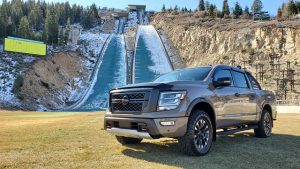
Its main weakness (aside from the short bed, even if you get the Crew Cab with the “long” one) is the same one that arguably besets every new half-ton truck. That defect being silly-high bedwalls that make putting stuff in the bed – and getting stuff out of it – awkard for even very tall people (I’m 6ft 3) and impossible for people who are short.
They will need to use a step ladder.
Why do they all have these silly-high bed walls? Part of the reason is it’s trendy. It’s a “look” that – apparently – lots of people like, though why is hard to comprehend. Like the look of the gnomesayin’ 22-inch “rims” so many vehicles now sport.
But there is another factor at work. It is – once again – the government at work. High bed walls help with aerodynamics and that helps with gas mileage. They also help with crash-testing.
The Rest
The Titan is still has an analog main guage cluster rather than an LCD flatscreen. If you don’t like these LCD flatscreens, this will appeal to you. Also appealing is the presence of old-school 12V power points, as opposed to USB-only.
There’s one more thing that’s unusual – unique, in fact – about the Titan. It’s the Titan XD – which is built to be tougher than a half-ton but not as massive and (for some) overwhelming as moving up to a three-quarter ton (2500) truck. It has a heavier-duty frame and is set up for gooseneck trailoring and can pull up to 11,033 lbs.
The Bottom Line
It is very – make that extremely – likely that the Titan will be profoundly altered for 2024. In the manner of altering your dog. This, therefore, is probably your last chance to buy an old truck that’s still brand-new.
. . .
Got a question about cars, Libertarian politics – or anything else? Click on the “ask Eric” link and send ’em in! Or email me at EPeters952@yahoo.com if the @!** “ask Eric” button doesn’t work!
If you like what you’ve found here please consider supporting EPautos.
We depend on you to keep the wheels turning!
Our donate button is here.
If you prefer not to use PayPal, our mailing address is:
EPautos
721 Hummingbird Lane SE
Copper Hill, VA 24079
PS: Get an EPautos magnet or sticker or coaster in return for a $20 or more one-time donation or a $10 or more monthly recurring donation. (Please be sure to tell us you want a magnet or sticker or coaster – and also, provide an address, so we know where to mail the thing!)
My eBook about car buying (new and used) is also available for your favorite price – free! Click here. If that fails, email me at EPeters952@yahoo.com and I will send you a copy directly!


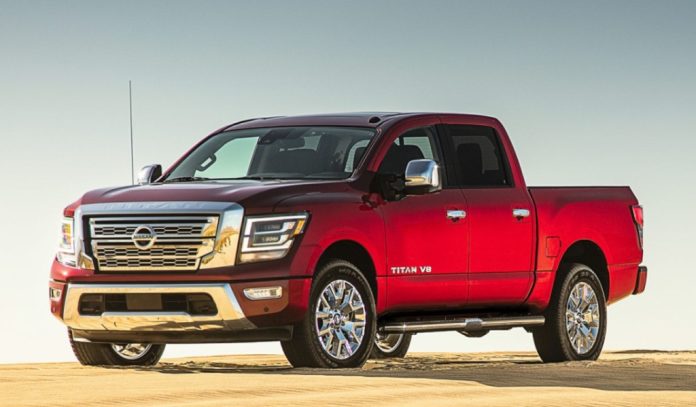

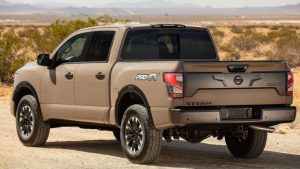
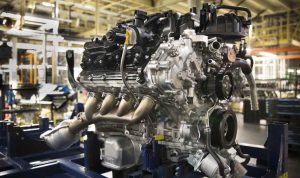
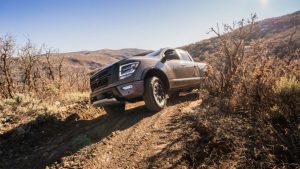
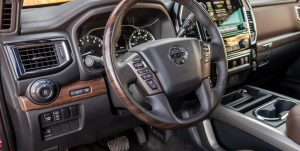








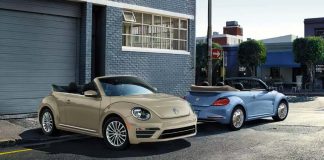
Thanks Eric. I would trade my 2018 F-150 for a Nissan Titan except for one thing. 36 gallon fuel tank vs a 26 gallon fuel tank. When I’m towing my 7,000 pound travel trailer getting 10mpg, that extra 10 gallons of gas is a life saver.
That’s the same complaint I have with my Frontier. I love the truck, even though I only get about 17 mpg. However, it only has a 16 gallon tank, so if I ran it to empty, that’s about 270 miles, but if course I get nervous on a trip at a quarter tank or so, which means I’m stopping for gas every 220 miles or thereabouts. Not much better than an electric, but, unlike an electric, I can fill up and be on my way in about 10 minutes. Even worse when I tow the small camper, mpg goes down to about 13, so I’m stopping about every 150 – 175 miles. Nissan definitely didn’t think thru the gas tank design on any of their trucks
It’s too bad Nissan doesn’t make a single cab 8 foot bed version that could get the starting price under 30k. I suppose they are trying to avoid the low rent image (that their cars sometimes have) that it would get if it populated too many rental lots and fleet sales. They didn’t help themselves to break into a very tough market by being as expensive as the big three competition though. They should have been more affordable at the beginning to build the business.
I am guessing there is no new generation in the works. The whole pickup disappears along with the V8. Eric, if there isn’t a next generation, do you think they could just sell it two or three more years before ending it? Or is the pressure to ditch the big engines that bad?
Hi Rich,
I agree with you – and Nissan used to, too! My previous-generation Frontier was available in a basic regular cab trim with the four cylinder engine and 4WD; I know because I owned a ’98. By ’04, you had to buy an extended cab and if you wanted 4WD you had to buy the V6.
This sort of upselling has always annoyed me.
So I will “cling” to my ’02 as long as I can and may eventually put a V6 in the thing so I can pull a small travel trailer with it….
Not sure how things are now, given the screwy state of the car market, both new and used, but in past years, you could really score a deal on Titans. They’re not terribly popular, and you could easily get 8 or 10k off sticker. Probably not the case anymore.
Had to look up the product in the final photo:
“It began in 1995 with patented Neuticles – testicular implantation for men – helping neuter- hesitant wives overcome the trauma of alteration, and allowing their beloved husband to retain his natural look and self esteem.’
Okay, I edited the text a little. But it does convey the general idea of giving an unsuspecting healthy truck a V8-ectomy to remove that ‘inappropriate’ bulge, and replacing it with a modest-sized, non-threatening V6 and a robust pair of Neuticles that will last a lifetime.
The Talk:
https://ibb.co/rK9C4Gy
Is there not a Cummins variant of the XD anymore?
Discontinued unfortunately. 2015-2019 model years only. Didn’t have much of a chance.
How sad we have reached a point where buying new gives you less than buying old
Dan,
Why would I spend 60k on a truck with a bed only 6″ longer than my 97 Tacoma’s? The Tacoma being long ago paid off. Why buy a full size truck if it won’t haul a sheet of plywood? Because they don’t make compacts anymore. I can’t tell a late model Tacoma from a full size truck unless they are parked next to each other, and the Tacoma is not MUCH smaller.
> Because they don’t make compacts anymore. I can’t tell a late model Tacoma from a full size truck unless they are parked next to each other, and the Tacoma is not MUCH smaller.
I first noticed that not long ago when I saw a late-model Colorado and a Silverado side-by-side at a light. The Colorado’s just a little bit narrower, but I’d swear it was nearly as long and tall.
More recently, I had to put my Rogue in the shop for what turned out to be some expensive repairs (including a transmission swap at a bit over 160k miles). It happened right as I was heading out of town on a camping trip, so I thought I’d ask the car-rental folks for a pickup. The paperwork said “full-size truck.” The nameplate on the truck said “Ranger,” not “F-150.” Pretty much the same comparison obtains as between the Colorado and Silverado. With four full doors, I’m pretty sure it was a fair bit longer than the ’02 S-10 I had way back when. Definitely taller, too (though my S-10 was lowered a bit at the factory and rolled on 16x8s instead of 15x7s).